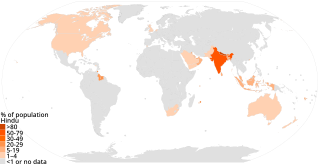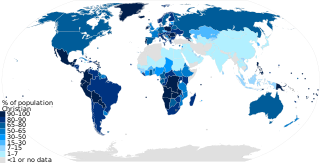
by percentage of country population
90–100% | |
70–90% | |
50–70% | Bosnia and Herzegovina |
30–40% | North Macedonia |
10–20% | |
5–10% | |
4–5% | |
2–4% | |
1–2% | |
< 1% |
| Islam by country |
|---|
 |
Islam is a minority religion in Liechtenstein.

90–100% | |
70–90% | |
50–70% | Bosnia and Herzegovina |
30–40% | North Macedonia |
10–20% | |
5–10% | |
4–5% | |
2–4% | |
1–2% | |
< 1% |
| Islam by country |
|---|
 |
Islam is a minority religion in Liechtenstein.
According to the census taken in the year 2000, there were an estimated 2,000 Muslims living in the country in 2009 (approximately 4.8% of the general population). [2] In the census of 2010, 5.4% of the population (1960 persons) were Muslims; the number rose to 5.9% in the 2015 census. [3]
In 2020, 6.27% of the population were Muslim. [4] According to the Pew Research Center, this number is projected to remain constant through 2030. [5]
The great majority of Muslims in Liechtenstein are Sunni, and are predominantly from Turkey, Kosovo, Bosnia and Herzegovina, and North Macedonia. [6] The census reports do not state what proportion of the Muslim population hold Liechtenstein citizenship.
Since 2001, the government has granted the Muslim community a residency permit for one imam, plus one short-term residency permit for an additional imam during Ramadan. The government follows a policy of routinely granting visas to the imams in exchange for the agreement of both the Turkish Association and the Islamic community to prevent religious diatribes by the imams or the spread of religious extremism. [7]
In 2006, the government made a contribution of US$20,000 (25,000 Swiss francs) to the Muslim community. [8]

Demographic features of the population of Turkey include population density, ethnicity, education level, health of the populace, economic status, religious affiliations and other aspects of the population.

Islam is the most practiced religion in Turkey. As much as 90% of the population follows Sunni Islam. Most Turkish Sunni Muslims belong to the Hanafi school of jurisprudence,The established presence of Islam in the region that now constitutes modern Turkey dates back to the later half of the 11th century, when the Seljuks started expanding into eastern Anatolia.

Hinduism has approximately 1.2 billion adherents worldwide. Hinduism is the third largest religion in the world behind Christianity (31.5%) and Islam (23.3%).

Islam is the second largest religion in the United Kingdom, with results from the 2011 Census giving the total population as 2,786,635, or 4.4% of the total UK population, while the 2021 Census results released so far show a population of 3,868,133 (6.5%) in England and Wales, 3,801,179 in England and 66,950 in Wales. The 2011 census reported 76,737 Muslims in Scotland (1.45%). London has the greatest population of Muslims in the country. The vast majority of Muslims in the United Kingdom adhere to Sunni Islam, while smaller numbers are associated with Shia Islam.

Islam in Switzerland has mostly arrived via immigration since the late 20th century. Numbering below 1% of total population in 1980, the fraction of Muslims in the population of permanent residents in Switzerland has quintupled in thirty years, estimated at just above 5% as of 2013. A majority is from Former Yugoslavia ; an additional 20% is from Turkey. This is due to the fact that in the 1960s and 1970s, Switzerland encouraged young men from Yugoslavia and Turkey to come as guest workers. Initially these young men were only planning on staying in Switzerland temporarily, however, revised Swiss immigration laws in the 1970s permitted family regrouping. Consequently, these men ended up staying in Switzerland as these new laws allowed the wives and children of these young men into the country. Since this time period, most of the Muslim immigration to Switzerland stems from asylum seekers arriving primarily from Eastern Europe.
Conversion to Islam is accepting Islam as a religion or faith and rejecting any other religion or irreligion.

As of the year 2023, Christianity had approximately 2.6 billion adherents and is the largest-religion by population respectively. According to a PEW estimation in 2020, Christians made up to 2.6 billion of the worldwide population of about 8 billion people. It represents nearly one-third of the world's population and is the largest religion in the world, with the three largest groups of Christians being the Catholic Church, Protestantism, and the Eastern Orthodox Church. The largest Christian denomination is the Catholic Church, with 1.3 billion baptized members. The second largest Christian branch is either Protestantism, or the Eastern Orthodox Church.

Islam is the second-largest religion in Europe after Christianity. Although the majority of Muslim communities in Western Europe formed recently, there are centuries-old Muslim societies in the Balkans, Caucasus, Crimea, and Volga region. The term "Muslim Europe" is used to refer to the Muslim-majority countries in the Balkans and parts of countries in Eastern Europe with sizable Muslim minorities that constitute large populations of native European Muslims, although the majority are secular.

Religion in Europe has been a major influence on today's society, art, culture, philosophy and law. The largest religion in Europe is Christianity, but irreligion and practical secularisation are strong. Three countries in Southeastern Europe have Muslim majorities. Ancient European religions included veneration for deities such as Zeus. Modern revival movements of these religions include Heathenism, Rodnovery, Romuva, Druidry, Wicca, and others. Smaller religions include Indian religions, Judaism, and some East Asian religions, which are found in their largest groups in Britain, France, and Kalmykia.

Muslim population growth is the population growth of Muslims worldwide. Between 2015 and 2060, Muslim population is projected to increase by 70%. This compares with the 32% growth of world population during the same period. The young median age and high fertility rate of Muslims relative to other religious groups are significant factors behind Islam's population growth. As of 2015, Muslims have the highest fertility rate of any religious group – an average of 2.9 children per woman, well above replacement level (2.1) —well above the global rate—but down from 4.3 in 1990–1995.
Asia is the largest and most populous continent and the birthplace of many religions including Buddhism, Christianity, Confucianism, Hinduism, Islam, Jainism, Judaism, Shinto, Sikhism, Taoism, and Zoroastrianism. All major religious traditions are practiced in the region and new forms are constantly emerging. Asia is noted for its diversity of culture.
Growth of religion involves the spread of individual religions and the increase in the numbers of religious adherents around the world. In sociology, desecularization is the proliferation or growth of religion, most commonly after a period of previous secularization. Statistics commonly measure the absolute number of adherents, the percentage of the absolute growth per-year, and the growth of converts in the world.

Islam is the largest religion in Turkey according to the state with 99.8% of the population being initially registered by the state as a Muslim. As much as 90% of the population follows Sunni Islam. Most Turkish Sunni Muslims belong to the Hanafi school of jurisprudence. The remaining 0.2% are Christians or adherents of other officially recognised religions like Judaism. The official number of Muslims include people who are irreligious; converted people and anyone who is of a different religion from their Muslim parents, but has not applied for a change of their individual records. These records can be changed or even blanked out on the request of the citizen, by filing an e-government application since May 2020, using a valid electronic signature to sign the electronic application. Any change in religion records additionally results in a new ID card being issued. Any change in religion record also leaves a permanent trail in the census record, however, record of change of religion is not accessible except for the citizen in question, next-of-kin of the citizen in question, the citizenship administration and courts.
Religion in Iran has been shaped by multiple religions and sects over the course of the country's history. Zoroastrianism was the main followed religion during the Achaemenid Empire, the Parthian Empire, and the Sasanian Empire. Another Iranian religion known as Manichaeanism was present in Iran during this period as well alongside Christianity, namely the Church of the East. Between 632 - 654 AD, the Rashidun Caliphate conquered Iran, and the next two centuries of Umayyad and Abbasid rule would see Iran, although initially resistant, gradually adopt Islam as the nation's predominant faith. Sunni Islam was the predominant form of Islam before the devastating Mongol conquest but subsequently, Shi'ism eventually became the predominant faith in Iran with the advent of the Safavid Empire (1501-1736).

Turkey is a secular state in accordance with Article 24 of its constitution. Secularism in Turkey derives from Mustafa Kemal Atatürk's Six Arrows: republicanism, populism, laïcité, reformism, nationalism and statism. The Turkish government imposes some restrictions on Muslims and other religious groups, as well as Muslim religious expression in government offices and state-run institutions, including universities.
Of the religions in Tunisia, Islam is the most prevalent. It is estimated that approximately 99% of Tunisia's inhabitants identify themselves as Muslims.
Islam is both the official and majority religion in the United Arab Emirates, professed by approximately 76% of the population. The Al Nahyan and Al Maktoum ruling families adhere to Sunni Islam of Maliki school of jurisprudence. Many followers of the Hanbali school of Sunni Islam are found in Sharjah, Umm al-Quwain, Ras al-Khaimah and Ajman. Their followers include the Al Qasimi ruling family. Other religions represented in the country including Christianity, Hinduism, Buddhism, Judaism and Sikhism are practiced by non-nationals.
The religion in Liechtenstein is predominantly Catholic, with a minority of Protestants, non-adherents, and adherents of other religions; it also has a small Muslim population, composed mainly of immigrants from countries including Bosnia and Herzegovina and Turkey.

Adherents of Islam constitute the world's second largest religious group. A projection by the PEW suggests that Muslims numbered approximately 1.9 billion followers in 2020. Studies in the 21st century suggest that, in terms of percentage and worldwide spread, Islam is the fastest-growing major religion in the world, mostly because Muslims have more children than other major religious groups. Most Muslims are either of two denominations: Sunni or Shia. Islam is the majority religion in several subregions: Central Asia, Western Asia, North Africa, West Africa, the Sahel, and the Middle East. The diverse Asia-Pacific region contains the highest number of Muslims in the world, easily surpassing the combined Middle East and North Africa.